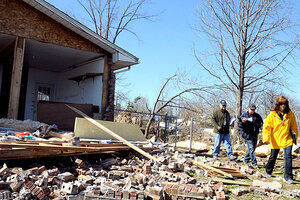Warm spring, more tornadoes? Meteorologists raise red flags.
An unusually balmy spring plus cold fronts are a formula for stronger thunderstorms and tornadoes, as hard-hit communities strive to be more resilient.

Illinois and Federal Emergency Management Agency officials walk through Harrisburg, Ill., which was hit by a tornado Feb. 29. FEMA said Monday that it will not help homeowners in Harrisburg.
Paul Newton/The Southern/AP
New York
As the residents of such tornado-stricken states as Indiana, Alabama, and Kentucky continue to clean-up from last week’s twisters, weather forecasters are warning that this spring could continue to see active weather systems with yet more severe weather. The main driver: a warmer than normal spring, à la 70 degrees in New York City on Monday and 70 degrees in Chicago by Wednesday. By Friday, it is expected to be in the 70s in Sioux Falls, S.D., about 30 degrees above normal.
As warm weather collides with cold fronts, the sharp temperature differential creates unstable weather conditions. At the same time, meteorologists say the Gulf of Mexico is slightly warmer than normal, providing the kind of moisture that can result in dangerous thunderstorms.
“This year conditions are more conducive than normal for extreme weather,” says Joe Lundberg, senior meteorologist at AccuWeather.com in State College, Pa. “We are getting off to an early and nasty start.”
He would get no argument from the residents of the central and southeast US where many extreme weather events take place. In February, according to the National Oceanic and Atmospheric Administration, 57 tornadoes were reported, nearly twice the 1991-2010 average of 29. The extreme weather has continued into March. For example, last week in southern Indiana, 13 people died after an F4 tornado – one of the largest – caused massive destruction.
Last year was a bad season for tornadoes as well with nearly 1,700 of the storms. In a more normal year there are 1,300 tornadoes.
The extreme weather is expected to continue possibly as early as late this coming weekend or early next week, says Mr. Lundberg. “From the Rockies through to the Plains, there could be another system with a lot of severe weather,” says the meteorologist. “The window we are looking at is Sunday through Tuesday.”
Nor is that likely to be end of the extreme weather, Lundberg says. He expects the abnormally warm weather to persist through March and possibly into the beginning of April before the temperatures start to get closer to normal. “What we think will eventually happen is the weather will shift towards a drier pattern, especially farther west,” he says. “We are not sure when that will happen, but it should start to stabilize the weather patterns.”
Although trying to respond to the disasters, federal officials are also attempting to get communities to plan and prepare better. On March 3, Craig Fugate, the administrator of the Federal Emergency Management Administration (FEMA) warned that the nation will ultimately reach a point where it can no longer afford to subsidize risk that is not mitigated.
“We cannot afford to continue to respond to disasters and deal with the consequences under the current model,” said Mr. Fugate in a speech at the National Press Club in Washington.
In fact, FEMA has turned down Illinois’ request for federal aid after a Feb. 29 tornado ripped through Harrisburg, Ill., killing seven people. "Based on our review of all the information available, it has been determined that the damage was not of such severity and magnitude as to be beyond the capabilities of the State, affected local governments and voluntary agencies," wrote the agency in turning down the state’s application.
Illinois officials have 30 days to appeal the ruling.
One of the new buzz words among some community organizers is “resilient communities” to describe places that can respond more quickly and effectively to extreme weather.
“We are talking about a place that can take a punch and get back up,” says Michael Schmitz, executive director of Local Governments for Sustainability USA, which is made up of 550 US communities concerned with clean energy and climate action. “We cannot avoid the extreme, so we have to prepare and plan.”
One of the places that has taken this lesson to heart is Parkersburg, Iowa, which was devastated by an EF5 tornado on May 25, 2008. For example, almost every house has a storm shelter, says Christopher Luhring, a city administrator.
In addition, Parkersburg added two storm shelters for city hall and is still in the process of backing up its town records. “It took months if not years to get the record back so we could function as a city,” says Mr. Luhring who was police chief when the tornado hit.
Luhring, who freely offers his advice to communities that are stricken, says it can be especially difficult to talk about ways to improve the community after a disaster. But, he says, it is essential. “We always said, we wanted a rapid recovery in the right way,” says Luhring.

